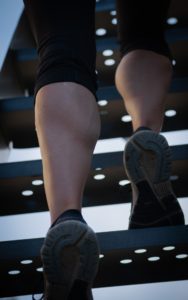 I was having a conversation with a friend recently. She was complaining that she hasn’t lost any weight at all even though she’s been walking “miles every day”. And she’s been doing that for years now. I tried to explain to her that walking for weight loss can be very effective if it’s done in the right way. But her routine needed a rehaul.
I was having a conversation with a friend recently. She was complaining that she hasn’t lost any weight at all even though she’s been walking “miles every day”. And she’s been doing that for years now. I tried to explain to her that walking for weight loss can be very effective if it’s done in the right way. But her routine needed a rehaul.
Haven’t we all heard that walking is a great form of exercise? And if you want to lose weight then you should start walking, right? This is all true, walking has many benefits, including weight loss. However, there are some basic rules of exercise that you need to know to get much more out of it.
As a personal trainer and health coach I really want to see people keep up their walking habits. So today I’ll tell you what you need to know about walking, and exercise in general, to help you with the weight loss you want.
Benefits of walking
Walking is great for weight loss and in general it’s just a good way to start being more physically active. One reason is that it’s easy to do and it doesn’t require any equipment other than comfortable shoes. And walking is something you can do anywhere. That’s a great checklist: easy, cheap, and convenient!
Walking is obviously a great workout for your leg and butt muscles but it’s also really good for your back. According to Dr. Andrew Cole, walking increases blood flow to the muscles and joints of your spine which brings more oxygen and nutrients to it. It helps to keep your body more flexible which increases your range of motion and lowers your risk of injury.
Back pain is one of the most common complaints in the U.S. medical system and is a leading cause of lost workdays. So anything we can do to keep our backs stronger will also give us a better quality of life.
I don’t think I need to point out that walking is good for your heart too but I’ll say it just in case! Heart disease is still our number one killer here in the U.S. The Blue Zones is the name given by Dan Buettner to the longest-lived cultures on earth. Even into their 90’s, it’s common practice for them to walk and engage in many other physical activities on a daily basis.
That’s in stark contrast to the 80% of Americans that don’t even get the recommended minimum amount of daily activity. And with over 600,000 Americans dying every year from heart disease, anything we can do to emulate those blue zones is a good idea.
Related article: Why do cardio for exercise?
The downside of walking for weight loss
So what’s the problem with walking for weight loss? The biggest one is that it doesn’t actually burn that many calories unless you’re doing some serious power walking.
That wouldn’t be a problem except that Americans take in so many extra calories every day with junk food and drinks! That means we’re constantly trying to offset our poor diets with exercise. And it’s hard to lose weight with exercise alone.
To illustrate, here’s a partial chart from nutristrategy.com that shows calories burned with walking. Notice the number of calories burned changes with different body weights. Also, keep in mind that this is for one hour of walking! So obviously, the longer and faster you walk the more calories you’ll burn.
| Activity for 1 hour |
130lb
|
155lb
|
180lb
|
205lb
|
| Walking 2.0 mph, slow |
148
|
176
|
204
|
233
|
| Walking 2.5 mph |
177
|
211
|
245
|
279
|
| Walking 3.0 mph, moderate |
195
|
232
|
270
|
307
|
| Walking 3.5 mph, brisk pace |
224
|
267
|
311
|
354
|
| Walking 3.5 mph, uphill |
354
|
422
|
490
|
558
|
| Walking 4.0 mph, very brisk |
295
|
352
|
409
|
465
|
| Walking 4.5 mph |
372
|
443
|
515
|
586
|
| Walking 5.0 mph |
472
|
563
|
654
|
745
|
The next time you go walking, be sure you know how far you go by driving your course first to calculate the miles. Then time yourself to see how long it takes you to walk it. This will give you a much better idea of what you’re accomplishing for calories burned.
But if you don’t want to have to work that hard then try cutting out some extra calories by consuming less junk. Fill yourself up with as many nutrient-dense natural foods first then save the “junk” as a treat if you’re still hungry. This is also a good strategy to give yourself more energy to want to move more.
Now let me explain some of the laws of exercise you need to know to be more successful at walking for weight loss.
Principles of overload and progression
In exercise science, there are some basic laws, or principles, that you need to follow to continue to get results with exercise. These are the Principles of Overload and Progression. According to ACE, the American Council on Exercise, they’re often combined to describe a training process known as “progressive overload”.
Overload refers to using a greater load than what your body is used to in order to continue to challenge it. So if you want your arms to get stronger you might start by lifting 5lbs, then move up to 7lbs, then 10lbs, then 12lbs. Common sense, right? But the same goes for walking, you have to continue to do more in order to keep challenging your body.
Progression is just the process of systematically applying that overload. In other words, when and how you’re going to progress yourself to a higher level. The way to do this with any exercise is to manipulate the frequency, intensity, duration and type of exercises you do.
This is called the FITT principle; meaning frequency, intensity, time and type. You always want to start with duration (time) first.
Applying these principles to walking
So how do you do more when it comes to walking? You should start a walking program with whatever you’re able to do. But every couple of weeks push yourself to go a little longer, maybe just 5 minutes more. Try to get yourself up to 45-60 minutes at a time. And make that time fly by listening to great music, a podcast, or an audiobook while you walk!
After you’ve gotten your duration up, you want to increase your frequency, or how many days a week you walk. Maybe you started with just 3 days of walking. So work up to 5 – 7 days, or whatever is realistic to you.
Finally, you’ll want to manipulate your intensity, which means walking faster to get your heart rate up more.
All of these progressions should take some time. Don’t expect it to happen overnight if you want to stick with it. It’s always better to take baby steps than to try to change everything at once.
Add some HIIT exercise to your walking routine
Now that you’ve changed the duration, frequency and intensity of your walking it’s time to add more variety to your routine. Lack of variety in exercise is a problem that most people unknowingly struggle with.
When you do the same type of exercise all the time you’re body just gets used to it. If you want continual progress then you need to implement the “progressive overload” principle and keep pushing yourself to do more.
At this point, I would suggest doing a HIIT walking program. This stands for high-intensity interval training. It means you do something to raise your heart rate for a short period of time, then take an active rest. The “active rest” means just walking again to bring your heart rate back down. Repeat that process for 10 – 20 minutes during your walk.
This is what that might look like. Walk for 5 minutes to warm up your body. Then do a series of 30 seconds “on” of some other higher intensity exercises, then 120 second “off” by going back to just walking.
These HI exercises could be things like light jogging, skipping, lateral shuffles, lunges, etc. These will add variety to your walking, raise your heart rate and use your muscles more. All good things.
For example, start with 30 seconds of jogging, then “rest” (walk) for 120 seconds. Then do 30 sec of skipping, then “rest” again for 120 sec. Then lateral shuffles and rest. Whatever you can think of to do, for 30 seconds at a time, that’s more intense than walking to make your walks harder.
All you need are 4-5 HI exercises that you can just keep repeating for 15 to 30 minutes. I think you get what I mean. After that, do a cool down by just walking easy for 5-10 minutes.
How to burn even more calories
There are two things you need to know to burn more calories during exercise.
First, the higher you get your heart rate up during exercise, the more calories you’ll be burning. Once you’ve done that HIIT walking routine for a while you can start to shorten your “rest” times. This will give you more overall time in a higher-intensity zone.
For example, do 30 sec of a HI exercise followed by just 60 sec of rest by walking. Then shorten the rest times to only 30 seconds. Again, it will take some time to work your way up to these shorter rest times. But that will give you months of progressions to work on.
The second thing you need to know about walking for weight loss is that you burn more calories when you have more muscle. Walking only really works your leg and core muscles. If you work on building more muscles in the rest of your body, you’ll burn more calories overall. Even when you’re not working out!
That means you need to add some strength training to your weekly workout program. This only needs to be done 2 days a week so it isn’t that hard and it doesn’t take that much time. I won’t get into any details about that in this article but you can read my blog “How to set up a balanced workout program” to learn more.
Why variety matters
Once you’ve progressed as much as you can with your walking program, then you want to try some other form of exercise for more variety. Each different type of exercise you do challenges your body in new ways which helps your overall strength and mobility.
So in a week you could just do 3 days of walking with some HIIT thrown in on one or two of those days. But in-between those walking days you could go bicycling, kayaking, swimming, or try some yoga. The point is that they’re all a little different so your body will be constantly challenged with new moves.
If you haven’t tried any exercise classes before then see what you can find that sounds interesting in your area. Classes are a great way to have more fun and learn something new. That’s good for your body and your mind! You might also make some new friends and social people tend to be healthier!
If you’re not a gym kind of person then try out some different cardio machines that you could buy for your own home. That way you can work out whenever you want. There are benefits to both classes and at-home workouts.
My final thoughts
Walking for weight loss is a great idea but if your body isn’t being continually challenged you’ll quit seeing any results. You have to keep making yourself work harder in order to keep losing weight and getting stronger. So follow my tips:
-
- Start with increasing the duration, frequency, intensity and type of your walking routine.
- Then add in some strength training a couple of days a week to build more muscle and burn more calories.
- And finally, add more variety to your weekly exercise program. Instead of just walking, find some other fun things to do that are totally different.
Doing these things will benefit you physically but also make exercising more fun. That helps with motivation to keep it up long term which is what it’s all about. Short-term exercise plans are pointless.
We have over 600 muscles in the human body and they’re all meant to be used. And although walking is great for your lower body, you need a strong upper body too. By keeping our muscles strong we can slow down the aging process and stay independent longer.
Working just some of our muscles over and over puts our bodies out of balance. That can lead to pain and stalled progress when it comes to weight loss and improved strength.
So keep up with the walking but do as many other activities as you can to work all those muscles. You’ll end up with a much better quality of life and have more fun while you’ve got it!
Related article: Don’t let age define you!

